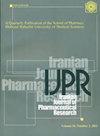Time-Dependent Molecular Changes Following MDMA-Induced Nephrotoxicity
IF 1.8
4区 医学
Q3 PHARMACOLOGY & PHARMACY
引用次数: 0
Abstract
: The increasing recreational use of ecstasy (MDMA) poses significant risks to human health, including reports of fatal renal failure due to its adverse renal effects. While MDMA-induced renal toxicity might result from systemic effects, there is also substantial evidence of direct harm to renal tissues by MDMA or its metabolites. The precise mechanisms underlying renal toxicity remain unclear. This study explored the impact of a single intraperitoneal dose of MDMA (20 mg/kg) on rat kidneys. Serum BUN and creatinine levels were evaluated to assess renal function, while TNF-α and TGF-β protein concentrations were measured using ELISA. mRNA levels of Bax, Bcl-xl, and Bcl-2 were quantified using quantitative RT-PCR. Additionally, apoptosis and histopathological changes in renal tissue were examined. Results showed a transient increase in serum BUN and creatinine in MDMA-treated rats. There were decreases in TNF-α and TGF-β levels in the renal tissue. Both pro-apoptotic Bax and anti-apoptotic Bcl-xl gene expressions were significantly reduced, whereas Bcl-2 expression and apoptosis did not show significant changes. No structural alterations were observed in the renal tissues. Overall, this study suggests that the renal adverse effects of MDMA may be mediated through the disruption of cytokine pathways, with notable reductions in TGF-β possibly linked to decreased TNF-α levels.亚甲二氧基甲基苯丙胺诱发肾毒性后的时间依赖性分子变化
:越来越多的人在娱乐中使用摇头丸(摇头丸),这给人类健康带来了巨大风险,包括因其对肾脏的不良影响而导致致命性肾衰竭的报告。虽然亚甲二氧基甲基苯丙胺诱发的肾毒性可能是全身效应的结果,但也有大量证据表明亚甲二氧基甲基苯丙胺或其代谢物对肾组织造成了直接伤害。肾毒性的确切机制仍不清楚。本研究探讨了单次腹腔注射亚甲二氧基甲基苯丙胺(20 毫克/千克)对大鼠肾脏的影响。通过评估血清 BUN 和肌酐水平来评估肾功能,同时使用酶联免疫吸附法测定 TNF-α 和 TGF-β 蛋白浓度,使用定量 RT-PCR 对 Bax、Bcl-xl 和 Bcl-2 的 mRNA 水平进行量化。此外,还检测了肾组织的凋亡和组织病理学变化。结果显示,经亚甲二氧基甲基苯丙胺处理的大鼠血清 BUN 和肌酐出现短暂升高。肾组织中的 TNF-α 和 TGF-β 水平有所下降。促细胞凋亡的 Bax 和抗细胞凋亡的 Bcl-xl 基因表达均显著减少,而 Bcl-2 的表达和细胞凋亡未出现显著变化。在肾组织中未观察到结构性改变。总之,这项研究表明,亚甲二氧基甲基苯丙胺对肾脏的不良影响可能是通过破坏细胞因子途径介导的,而 TGF-β 的明显减少可能与 TNF-α 水平的降低有关。
本文章由计算机程序翻译,如有差异,请以英文原文为准。
求助全文
约1分钟内获得全文
求助全文
来源期刊
CiteScore
3.40
自引率
6.20%
发文量
52
审稿时长
2 months
期刊介绍:
The Iranian Journal of Pharmaceutical Research (IJPR) is a peer-reviewed multi-disciplinary pharmaceutical publication, scheduled to appear quarterly and serve as a means for scientific information exchange in the international pharmaceutical forum. Specific scientific topics of interest to the journal include, but are not limited to: pharmaceutics, industrial pharmacy, pharmacognosy, toxicology, medicinal chemistry, novel analytical methods for drug characterization, computational and modeling approaches to drug design, bio-medical experience, clinical investigation, rational drug prescribing, pharmacoeconomics, biotechnology, nanotechnology, biopharmaceutics and physical pharmacy.

 求助内容:
求助内容: 应助结果提醒方式:
应助结果提醒方式:


